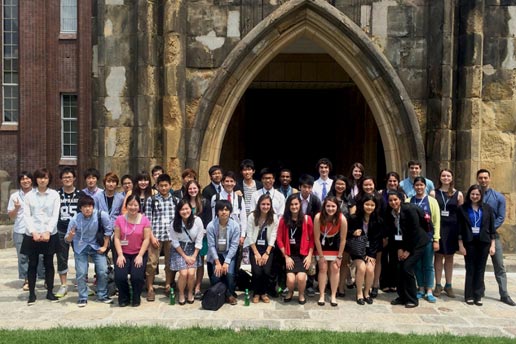
Today’s materials scientists are expected to join multidisciplinary teams to solve real-world problems. A cooperative materials science course between MIT and the University of Tokyo is teaching students at both schools to incorporate social, political, and economic factors into large-scale engineering solutions.
Now in its seventh year at MIT, the semester-long Global Principles of Engineering Practice class, developed by Department of Materials Science and Engineering (DMSE) Professor Lionel Kimerling, began for freshmen only. It expanded to include the Japanese component in 2010 and a year later added a laboratory component to open it to upperclassmen at MIT as well.
Principles to practice
During the program, students learn seven engineering principles and then break into teams to apply those to a particular project. At the end of the semester, a group from MIT travels to the University of Tokyo in Japan for a symposium at which students listen to each other’s problem definitions and solutions. “Labs, case studies, and the projects are the things that the students do, and the principles are the context with which we ask them to practice,” says Kimerling, who is the Thomas Lord Professor of Materials Science and Engineering at MIT.
The weeklong spring trip to Japan for the MIT students has grown from three students in 2010 to 20 students in 2015. This year’s symposium was May 23. Team Metafora tackled the topic “Creating an Accessible and Efficient Transportation System in Boston by 2065.”
Team Metafora member Reva Butensky found the in-person interactions with Japanese students to be the most valuable part of the trip. “Each excursion was a breeding ground for conversation (however taboo for a normally quiet train car) and a cultural information exchange unparalleled by anything I could have absorbed or learned from a textbook or cursory Internet search engine search,” she wrote in her report on the class. Team member Isaac Cabrera is in Japan for a summer internship at JFE Steel. “Almost all comment on the politeness and high regard for visitors they experienced in Japan versus what they might expect Japanese visitors would experience in the U.S.,” Kimerling says.
While Tokyo students are given the same general topics to tackle, their approaches mirror their different societal norms. Citing the 2014 experience, Kimerling explains, “In a transportation project, for instance, where our team was worrying about how do you get the most cars in and out of Boston and connecting with the most suburbs and things like that, the Japanese were worrying how do old people get transported around the city when they are in wheelchairs and they don’t have accessible public transportation. The same problem — people getting people around in the cities — but two different problem definitions and major different solutions.” Other project topics included solar energy, disaster preparedness, and an effective STEM education system.
Important problems
Students have shown a strong ability to pick problems important to society and to find solutions that are close to optimized, Kimerling says. “In going through that process, they have to consider the social, political, and economic, as well as the engineering and technology dimensions of it. Without a doubt, almost every one of these project solutions ends up being implemented in some way in the real world.”
“The whole idea is that the students who participate in this and are able to benefit from it will form a core of what we today call ‘small-planet’ engineers,” Kimerling says. “So, the hope is that it will be the beginning of an education methodology that’s sustainable and producing students who appreciate multidimensional (social, political, economic, technology) engineering practice.”
Upperclassmen take a 12-hour lab version of the class, Global Principles of Engineering Practice (3.004), which can be credited toward the energy minor at MIT. They are required to turn a blank silicon wafer into a solar cell. In the process, they learn about diffusion, metallization, photolithography, spin coating, and characterization. “At the end, they have a cell, they test it, and they’ve done an energy component of the course that is applying some of the larger design optimization principles that they’ve learned in the rest of the course,” Kimerling explains. For freshmen, the course (3.003) is nine hours.
Engineering principles
The engineering principles covered by the course are: system thinking; problem definition (technology); design: performance, constraints and optimization; human agency (social); ecology, renewables, and scaling (economic); quantitative analysis (technology); and engineering and the political system (political). The principles have often been amplified by guest lectures from professors Frank Field III, Randolph Kirchain, Elsa Olivetti, Richard Samuels, Jessika Trancik, William Uricchio, and Christopher Weaver.
To prepare for working with the Japanese students and visiting Japan, MIT Global Principles students hear a one-hour lecture on Japanese culture by a representative of MISTI Japan. Besides the symposium, the students tour Japanese industry sites, such as an automobile plant and a blast furnace for steelmaking, and visit Japanese cultural, religious, and historic sites.
The Global Principles class model has potential to expand by becoming modularized so different professors can incorporate the international content into their own courses. The Center For International Studies at MIT and the Lord Foundation have helped support the course.